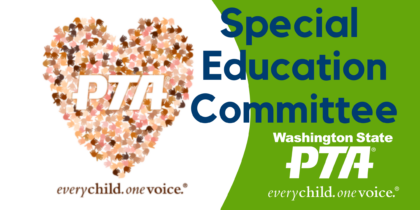Special Education
Washington State PTA has consistently advocated for fully funding education since the 1980s. Special Education started to be a Legislative Priority starting in the 1989 to 1990 Legislative Session.
The Washington State PTA supports families and students with disabilities in the following ways:
2025-2026 Top 5 Legislative Priorities – Addressing Funding, Inclusion, and
Supports in Special Education
Creation of the Special Education Committee Fall of 2022
- Email the chairs of this committee: specialeducation@wastatepta.org
Washington State PTA has educated PTA leaders about how to support families and students with disabilities at the Convention and other Regional training events. Washington State PTA has been supporting Special Education PTAs since 2006, and they now support 10 Special Education PTAs across the state. These Special Education PTAs run differently than a local school PTA because instead of serving a single school community they serve their entire district. Special Education PTAs often partner with their local school PTAs to include and support families with disabled students in their schools and communities.
Washington State Special Education PTAs
What is Inclusion? (from OSPI site)
- Definition: Inclusion is the belief that all students have a right to meaningfully participate in the general education setting, both academically and socially. Inclusion is realized when all students, regardless of their designation to receive special education services, are provided with targeted services, supports, and accommodations; allowing them to learn in the general education classroom, interact with peers, and engage the core curriculum. Inclusive instruction rebukes the problematic perspective that students receiving special education services need to ‘fit in’ or ‘earn their way’ into general education classes. The belief that general education instruction is not malleable and that students should be making adaptations to be included in the general education setting has contributed to the continuation of two parallel systems of education in which students receiving special education services are marginalized and devalued because of their environmental segregation.
- Inclusion Benefits Everyone: Extensive research on the efficacy of inclusion shows that inclusive instruction yields significant improvements in the academic performance of students receiving special education services–in all subjects–and improvements in social and emotional outcomes as compared to teaching in separate settings. Students who received special education services, who spend 80– 100% of their time in the regular classroom, develop better working habits, improved self-esteem, are more attentive, have improved social competencies, and have more diverse friendship networks. Students who do not have an identified disability or an individual education program (IEP) also see improved academic outcomes as the high-leverage teaching techniques used in inclusive classrooms [e.g., multi-tiered system of supports (MTSS), universal design for learning (UDL), specially designed instruction (SDI), and culturally responsive teaching (CRT)] help all students learn in ways that work best for their individual styles and needs. These students also see improved social outcomes as they learn to see beyond people’s disabilities and develop a greater appreciation for diversity.
- Inclusionary Practices Technical Assistance Network | OSPI (www.k12.wa.us)
